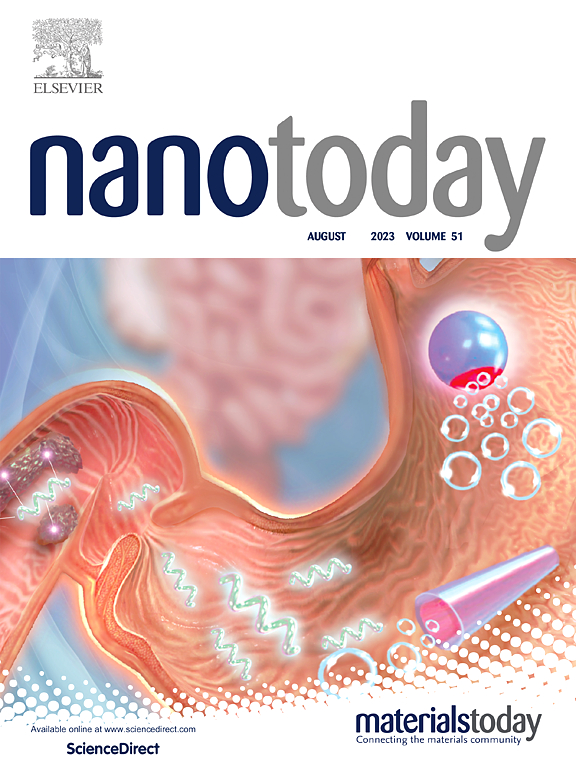NTR rapidly activated photosensitizers for high-signal-to-noise imaging and type I photodynamic therapy
IF 13.2
1区 材料科学
Q1 CHEMISTRY, MULTIDISCIPLINARY
引用次数: 0
Abstract
Although nitroreductase (NTR) response-based photosensitive dyes have been widely developed for active photodynamic therapy, their small Stokes shift, uncontrolled enzymatic reaction rates, and poor photodynamic effect have resulted in unsatisfactory biological imaging and therapeutic applications of dyes. In particular, the sensitivity of the probe is more required to reveal the relationship between hypoxia-inducible factors-1α (HIF-1α) and NTR. Traditional hemicyanine dyes by the introduction of benzyl nitrobenzene were used for bioimaging and photodynamic therapy. Due to the relatively weak electron-withdrawing contribution of indole salt, the dye has longer absorption wavelength and slow response to NTR with a small Stokes shift. Thus, we choose pyridine salt with strong electron-withdrawing ability to replace the indole part. The increased ability to electron-withdrawing leads to an uneven charge distribution, which shortens the conjugation length resulting in the absorption blue shift and the Stokes shift increasing. Further, the nitro group directly was connected on the other side of the fluorophore to improve the reduction potential of the dye. In this way, not only NTR can respond nitro quickly, but also photosensitive dye is prone to electron transfer, which can realize type I photodynamic therapy. Interestingly, we found that the HIF-1α can regulate NTR level through bioimaging with such a well-performing probe, and that inhibitors of HIF-1α can inhibit the expression of NTR, while inhibitors of NTR are ineffective in inhibiting HIF-1α.
NTR快速激活光敏剂用于高信噪比成像和I型光动力治疗
虽然基于硝基还原酶(NTR)反应的光敏染料已广泛用于活性光动力治疗,但它们的斯托克斯位移小,酶反应速率不受控制,光动力效果差,导致染料的生物成像和治疗应用不理想。特别是,探针的灵敏度更需要揭示缺氧诱导因子-1α (HIF-1α)与NTR之间的关系。引入苄基硝基苯的传统半花青素染料用于生物成像和光动力治疗。由于吲哚盐的吸电子贡献相对较弱,染料的吸收波长较长,对NTR的响应较慢,Stokes位移较小。因此,我们选用吸电子能力强的吡啶盐代替吲哚部分。吸电子能力的增强导致电荷分布不均匀,从而缩短了共轭长度,导致吸收蓝移和斯托克斯位移增大。此外,将硝基直接连接在荧光团的另一侧,以提高染料的还原电位。这样,不仅NTR可以快速响应硝基,而且光敏染料容易发生电子转移,可以实现I型光动力治疗。有趣的是,我们发现HIF-1α可以通过这种性能良好的探针生物成像调节NTR水平,并且HIF-1α抑制剂可以抑制NTR的表达,而NTR抑制剂对HIF-1α的抑制无效。
本文章由计算机程序翻译,如有差异,请以英文原文为准。
求助全文
约1分钟内获得全文
求助全文
来源期刊

Nano Today
工程技术-材料科学:综合
CiteScore
21.50
自引率
3.40%
发文量
305
审稿时长
40 days
期刊介绍:
Nano Today is a journal dedicated to publishing influential and innovative work in the field of nanoscience and technology. It covers a wide range of subject areas including biomaterials, materials chemistry, materials science, chemistry, bioengineering, biochemistry, genetics and molecular biology, engineering, and nanotechnology. The journal considers articles that inform readers about the latest research, breakthroughs, and topical issues in these fields. It provides comprehensive coverage through a mixture of peer-reviewed articles, research news, and information on key developments. Nano Today is abstracted and indexed in Science Citation Index, Ei Compendex, Embase, Scopus, and INSPEC.
 求助内容:
求助内容: 应助结果提醒方式:
应助结果提醒方式:


